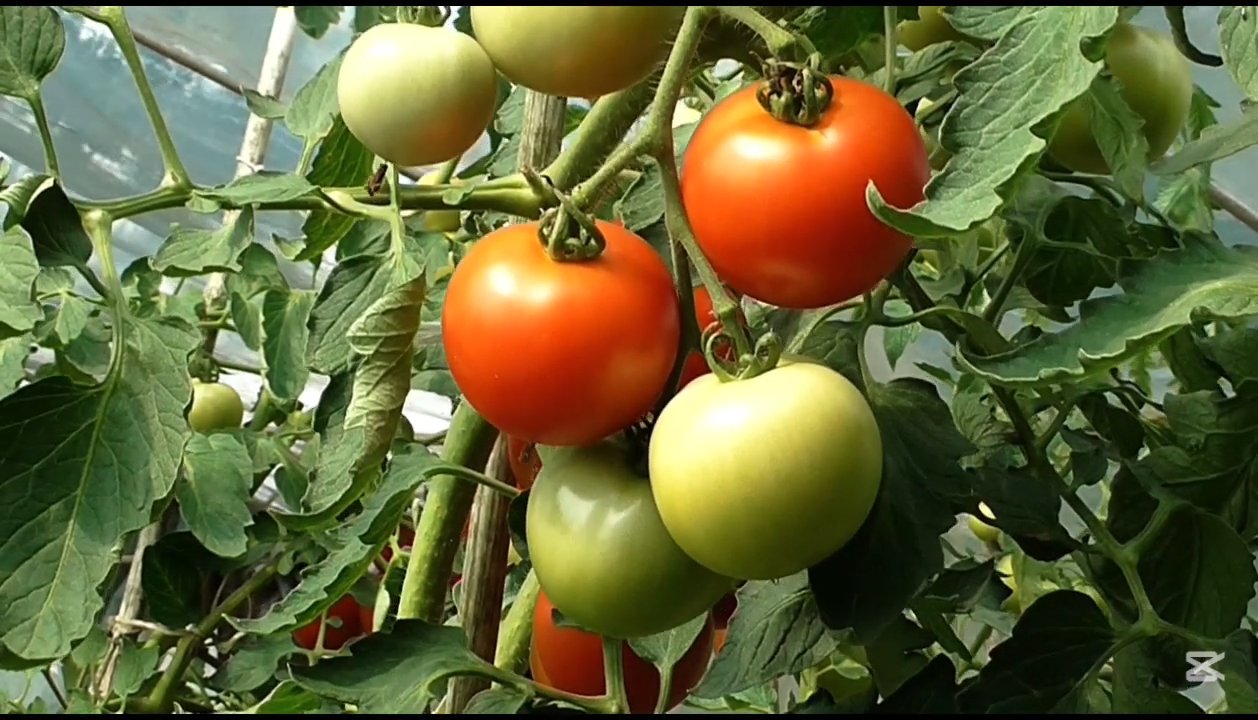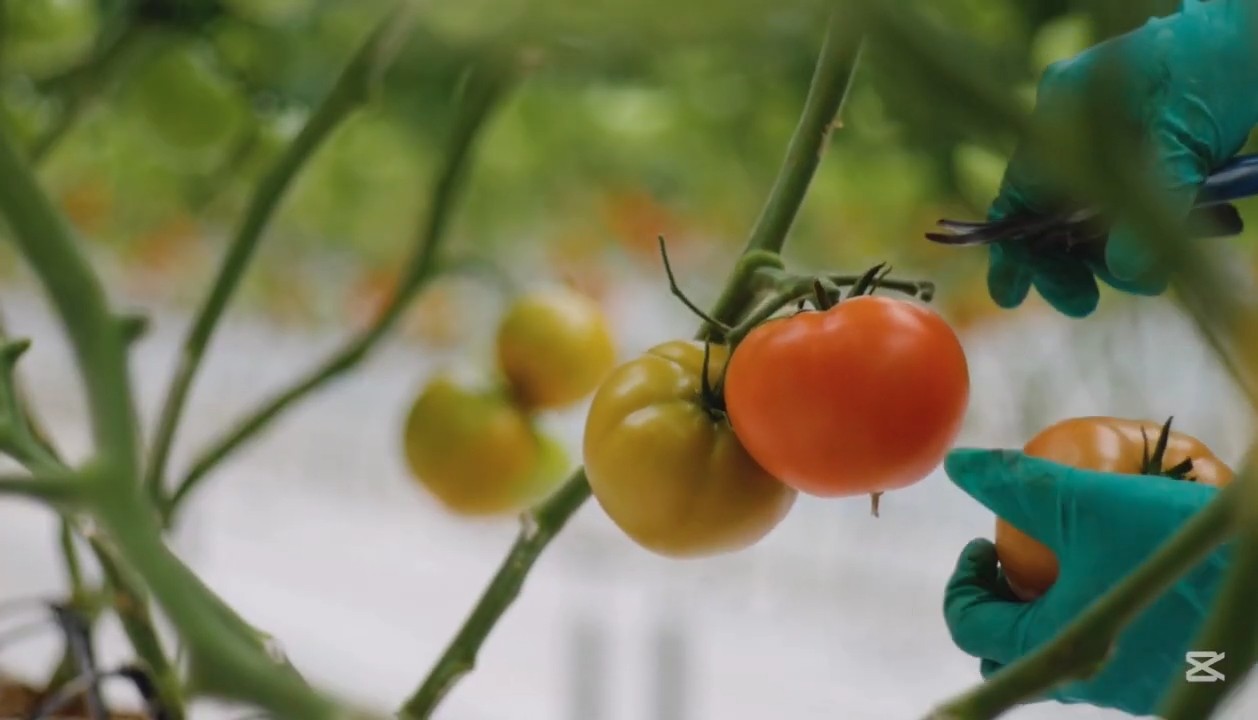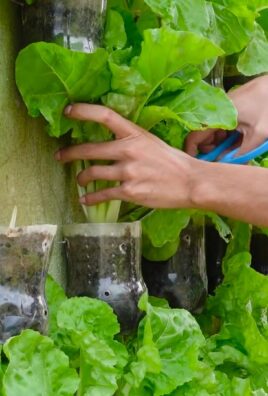Growing tomatoes in small spaces can feel like an impossible dream, especially if you’re living in an apartment or have a tiny backyard. But guess what? It’s totally achievable, and I’m here to show you how! For centuries, cultivating tomatoes has been a cherished tradition, deeply rooted in cultures worldwide. From the sun-drenched fields of Italy to the vibrant gardens of Mexico, the juicy, flavorful tomato has held a special place in our hearts and on our plates.
But what if you don’t have acres of land to dedicate to your tomato obsession? That’s where these clever DIY tricks and hacks come in. Imagine plucking ripe, sun-warmed tomatoes straight from your balcony, ready to be tossed into a fresh salad or simmered into a delicious sauce. No more bland, store-bought tomatoes!
In today’s world, where access to fresh, healthy produce can be a challenge, learning how to maximize your limited space for growing tomatoes in small spaces is more important than ever. Not only will you enjoy the incredible flavor of homegrown tomatoes, but you’ll also experience the satisfaction of nurturing your own food source. Plus, it’s a fantastic way to de-stress and connect with nature, even in the heart of the city. So, let’s dive in and unlock the secrets to a bountiful tomato harvest, no matter how small your space may be!

Growing Tomatoes in Small Spaces: A DIY Guide to Bountiful Harvests
Hey there, fellow gardening enthusiasts! Dreaming of juicy, sun-ripened tomatoes but short on space? Don’t despair! I’m here to tell you that even with a tiny balcony, a small patio, or just a sunny windowsill, you can absolutely grow your own delicious tomatoes. I’ve done it, and I’m excited to share my secrets with you. This guide will walk you through everything you need to know, from choosing the right varieties to troubleshooting common problems. Let’s get started!
Choosing the Right Tomato Variety
The key to success in small-space tomato gardening is selecting the right varieties. Forget those sprawling, indeterminate giants that need acres of land. We’re looking for compact, determinate, or dwarf varieties that thrive in containers.
* Determinate Tomatoes: These are bush-type tomatoes that grow to a certain size and then stop, producing all their fruit at once. They’re perfect for canning or making sauce.
* Indeterminate Tomatoes: These keep growing and producing fruit throughout the season. While some indeterminate varieties can get huge, there are smaller, more manageable options.
* Dwarf Tomatoes: These are the true champions of small-space gardening. They’re bred to be compact and bushy, producing delicious tomatoes on small plants.
Here are some of my favorite small-space tomato varieties:
* ‘Tiny Tim’: A super-compact determinate variety that produces tiny, cherry-sized tomatoes. Perfect for hanging baskets or small pots.
* ‘Patio’: A determinate variety that grows to about 2-3 feet tall, producing medium-sized tomatoes. Great for containers on patios or balconies.
* ‘Roma’: A determinate variety known for its paste-type tomatoes, ideal for making sauces and canning.
* ‘Bush Early Girl’: A determinate version of the popular ‘Early Girl’ variety, offering early and abundant harvests.
* ‘Micro Tom’: The smallest tomato variety available, growing only 6-8 inches tall. Perfect for windowsills or tiny spaces.
* ‘Balcony Tomato’: As the name suggests, this variety is specifically bred for balcony gardening. It’s compact and produces a good yield.
* ‘Tumbling Tom’: A trailing variety that’s perfect for hanging baskets. It produces sweet, cherry-sized tomatoes.
Gathering Your Supplies
Before you start planting, you’ll need to gather your supplies. Here’s a checklist:
* Containers: Choose containers that are at least 12 inches in diameter and 12 inches deep. Larger is generally better, as it gives the roots more room to grow. Fabric pots are a great option, as they allow for better drainage and aeration.
* Potting Mix: Use a high-quality potting mix that’s specifically formulated for containers. Avoid using garden soil, as it can compact and drain poorly.
* Tomato Seedlings or Seeds: You can start your tomatoes from seed or purchase seedlings from a local nursery. If you’re starting from seed, start them indoors 6-8 weeks before the last expected frost.
* Tomato Cage or Stake: Even compact tomato varieties can benefit from support. A tomato cage or stake will help keep the plants upright and prevent the fruit from touching the soil.
* Fertilizer: Use a balanced fertilizer that’s specifically formulated for tomatoes. Look for a fertilizer with an NPK ratio of around 5-10-5.
* Watering Can or Hose: You’ll need a way to water your tomatoes regularly.
* Pruning Shears or Scissors: For pruning suckers (more on that later).
* Optional: Mulch (straw, wood chips, or shredded leaves) to help retain moisture and suppress weeds.
Planting Your Tomatoes
Now for the fun part – planting! Here’s how to plant your tomatoes in containers:
1. Prepare the Container: Fill your container with potting mix, leaving about an inch or two of space at the top.
2. Plant the Seedling: If you’re using a seedling, gently remove it from its container. Loosen the roots slightly and plant the seedling deep in the potting mix, burying the stem up to the first set of leaves. This will encourage the plant to develop more roots.
3. Water Thoroughly: Water the newly planted tomato thoroughly until water drains out of the bottom of the container.
4. Add Support: Install a tomato cage or stake to provide support for the plant as it grows.
5. Mulch (Optional): Add a layer of mulch around the base of the plant to help retain moisture and suppress weeds.
Caring for Your Tomatoes
Once your tomatoes are planted, it’s important to provide them with the care they need to thrive.
* Watering: Tomatoes need consistent watering, especially when they’re fruiting. Water deeply whenever the top inch of soil feels dry to the touch. Avoid overwatering, as this can lead to root rot.
* Fertilizing: Fertilize your tomatoes every 2-3 weeks with a balanced tomato fertilizer. Follow the instructions on the fertilizer package.
* Sunlight: Tomatoes need at least 6-8 hours of sunlight per day. Place your containers in a sunny location.
* Pruning: For indeterminate tomato varieties, it’s important to prune suckers. Suckers are small shoots that grow in the “armpit” between the main stem and a branch. Removing suckers will encourage the plant to focus its energy on producing fruit. Use pruning shears or scissors to snip off the suckers when they’re small. Determinate varieties generally don’t need pruning.
* Pest and Disease Control: Keep an eye out for pests and diseases. Common tomato pests include aphids, whiteflies, and tomato hornworms. Common tomato diseases include early blight, late blight, and blossom end rot. Treat pests and diseases promptly with appropriate organic or chemical controls.
* Pollination: While tomatoes are self-pollinating, sometimes they need a little help, especially if you’re growing them indoors. Gently shake the plants or use a small brush to transfer pollen from one flower to another.
Troubleshooting Common Problems
Even with the best care, you may encounter some problems when growing tomatoes. Here are some common issues and how to address them:
* Blossom End Rot: This is a condition where the bottom of the tomato turns black and leathery. It’s caused by a calcium deficiency, which is often due to inconsistent watering. To prevent blossom end rot, water your tomatoes consistently and add calcium to the soil.
* Early Blight: This is a fungal disease that causes brown spots on the leaves. To prevent early blight, water your tomatoes at the base of the plant, avoid overhead watering, and remove any infected leaves.
* Late Blight: This is another fungal disease that can quickly kill tomato plants. To prevent late blight, choose disease-resistant varieties, provide good air circulation, and apply a fungicide if necessary.
* Aphids: These small, sap-sucking insects can weaken tomato plants. To control aphids, spray them with a strong stream of water or use insecticidal soap.
* Tomato Hornworms: These large caterpillars can quickly defoliate tomato plants. Handpick them off the plants or use Bacillus thuringiensis (Bt), a natural insecticide.
* Yellowing Leaves: Yellowing leaves can be caused by a variety of factors, including nutrient deficiencies, overwatering, and underwatering. Check the soil moisture and nutrient levels and adjust your watering and fertilizing accordingly.
Harvesting Your Tomatoes
The moment you’ve been waiting for – harvesting your tomatoes! Tomatoes are ready to harvest when they’re fully colored and slightly soft to the touch. Gently twist the tomato off the vine. Enjoy your homegrown tomatoes in salads, sandwiches, sauces, or just eat them straight off the vine!
Extending the Growing Season
If you live in a climate with a short growing season, you can extend the season by starting your tomatoes indoors and using row covers or cold frames to protect them from frost. You can also grow tomatoes in containers that can be moved indoors during cold weather.
Tips for Success
Here are a few extra tips to help you succeed in growing tomatoes in small spaces:
* Choose the right container: Make sure your container is large enough for the variety you’re growing.
* Use high-quality potting mix: Avoid using garden soil, as it can compact and drain poorly.
* Water consistently: Tomatoes need consistent watering, especially when they’re fruiting.
* Fertilize regularly: Fertilize your tomatoes every 2-3 weeks with a balanced tomato fertilizer.
* Provide support: Use a tomato cage or stake to support the plants.
* Prune suckers (for indeterminate varieties): Removing suckers will encourage the plant to focus its energy on producing fruit.
* Protect from pests and diseases: Keep an

Conclusion
So, there you have it! Growing tomatoes in small spaces isn’t just a pipe dream; it’s an achievable reality with a little ingenuity and the right approach. We’ve explored how to maximize your yield, even if you’re limited to a balcony, patio, or even just a sunny windowsill. From selecting the perfect compact varieties to mastering container gardening techniques, you’re now equipped with the knowledge to cultivate your own delicious, homegrown tomatoes.
Why is this DIY trick a must-try? Because it empowers you to enjoy the unparalleled flavor of fresh, vine-ripened tomatoes, regardless of your living situation. Store-bought tomatoes simply can’t compare to the burst of sweetness and tanginess you get from a tomato nurtured with your own hands. Plus, it’s incredibly rewarding to watch your plants thrive and produce a bounty of fruit. It’s a sustainable way to add fresh produce to your diet and connect with nature, even in the heart of the city.
But don’t stop there! Experiment with different tomato varieties to discover your favorites. Try ‘Patio Princess’ for its compact size and prolific yield, or ‘Tiny Tim’ for its adorable, bite-sized fruits. Consider adding companion plants like basil or marigolds to your tomato containers to deter pests and enhance flavor. You can also explore different container types, from traditional pots to hanging baskets or even repurposed containers like buckets or grow bags. The possibilities are endless!
Growing tomatoes in small spaces is also a fantastic way to reduce your carbon footprint. By growing your own food, you’re minimizing the need for transportation and packaging, contributing to a more sustainable lifestyle. Plus, it’s a great way to get some exercise and fresh air, and it can be a fun and educational activity for the whole family.
We encourage you to embrace this DIY project and experience the joy of growing your own tomatoes. Don’t be afraid to get your hands dirty and experiment with different techniques. Remember, gardening is a learning process, and even experienced gardeners encounter challenges along the way. The key is to be patient, observant, and willing to adapt your approach as needed.
And most importantly, we want to hear about your experiences! Share your tips, successes, and challenges in the comments below. Let us know what tomato varieties you’re growing, what container gardening techniques you’ve found most effective, and any other advice you have for fellow small-space gardeners. Together, we can create a thriving community of tomato enthusiasts and inspire others to embrace the joys of homegrown produce. So, grab your seeds, pots, and soil, and get ready to embark on a delicious and rewarding gardening adventure! Let’s make this season the most fruitful one yet, even in our limited spaces. This method of growing tomatoes in small spaces is a game changer.
Frequently Asked Questions (FAQ)
What are the best tomato varieties for small spaces?
Choosing the right tomato variety is crucial for success in small-space gardening. Determinate or bush varieties are generally preferred because they grow to a compact size and produce all their fruit at once. Indeterminate or vining varieties, on the other hand, continue to grow and produce fruit throughout the season, requiring more space and support.
Some excellent determinate tomato varieties for small spaces include:
* ‘Patio Princess’: A compact and prolific variety that produces small to medium-sized red tomatoes.
* ‘Tiny Tim’: A miniature variety that produces bite-sized red tomatoes, perfect for salads and snacking.
* ‘Roma’: A classic paste tomato that’s ideal for making sauces and canning.
* ‘Celebrity’: A versatile variety that produces medium-sized red tomatoes with excellent flavor.
* ‘Bush Early Girl’: A compact version of the popular ‘Early Girl’ variety, known for its early and abundant yields.
Indeterminate varieties can also be grown in small spaces with proper support and pruning. Consider these options:
* ‘Tumbler’: A cascading variety that’s perfect for hanging baskets.
* ‘Sweet Million’: A prolific cherry tomato variety that produces clusters of sweet, bite-sized fruits.
* ‘Black Cherry’: An heirloom variety with a unique smoky flavor and dark purple fruits.
What size container do I need for growing tomatoes?
The size of the container depends on the tomato variety you’re growing. Determinate varieties generally need a container that’s at least 12 inches in diameter and 12 inches deep, while indeterminate varieties require a larger container that’s at least 18 inches in diameter and 18 inches deep.
Make sure the container has drainage holes to prevent waterlogging, which can lead to root rot. You can also use self-watering containers, which help to regulate moisture levels and reduce the need for frequent watering.
What type of soil should I use for growing tomatoes in containers?
Use a high-quality potting mix that’s specifically formulated for container gardening. Avoid using garden soil, as it can become compacted in containers and doesn’t drain well. A good potting mix should be lightweight, well-draining, and rich in organic matter.
You can also amend your potting mix with compost or other organic materials to improve its fertility and water-holding capacity. Consider adding a slow-release fertilizer to provide your tomato plants with a steady supply of nutrients throughout the growing season.
How much sunlight do tomatoes need?
Tomatoes need at least 6-8 hours of direct sunlight per day to thrive. Choose a location that receives plenty of sunlight, such as a south-facing balcony or patio. If you don’t have enough sunlight, you can supplement with grow lights.
How often should I water my tomato plants?
Water your tomato plants regularly, especially during hot, dry weather. Check the soil moisture by sticking your finger into the soil. If the top inch of soil feels dry, it’s time to water. Water deeply, until the water drains out of the bottom of the container.
Avoid overwatering, as this can lead to root rot. Also, try to water at the base of the plant, rather than overhead, to prevent fungal diseases.
How do I fertilize my tomato plants?
Fertilize your tomato plants every 2-3 weeks with a balanced fertilizer that’s specifically formulated for tomatoes. Look for a fertilizer that’s high in phosphorus, which promotes fruit development.
You can also use organic fertilizers, such as compost tea or fish emulsion. Follow the instructions on the fertilizer label carefully to avoid over-fertilizing, which can damage your plants.
How do I support my tomato plants?
Indeterminate tomato varieties need support to prevent them from sprawling and breaking under the weight of their fruit. Use stakes, cages, or trellises to support your tomato plants.
Insert the support structure into the container when you plant your tomato seedlings to avoid damaging the roots later on. Tie the tomato stems to the support structure with soft twine or plant ties.
How do I prune my tomato plants?
Pruning can help to improve air circulation, reduce disease, and encourage fruit production. Remove suckers, which are small shoots that grow between the main stem and the branches. These suckers can divert energy away from fruit production.
Also, remove any yellowing or diseased leaves to prevent the spread of disease. Prune your tomato plants regularly throughout the growing season.
How do I deal with pests and diseases?
Monitor your tomato plants regularly for pests and diseases. Common tomato pests include aphids, whiteflies, and tomato hornworms. Common tomato diseases include early blight, late blight, and blossom end rot.
Use organic pest control methods, such as insecticidal soap or neem oil, to control pests. Prevent diseases by providing good air circulation, avoiding overhead watering, and removing any diseased leaves.
If you encounter blossom end rot, which is caused by a calcium deficiency, add calcium to the soil by amending with bone meal or eggshells.
Can I grow tomatoes indoors?
Yes, you can grow tomatoes indoors, but you’ll need to provide them with plenty of light and warmth. Choose a sunny windowsill or use grow lights to provide at least 12-14 hours of light per day.
Also, make sure to pollinate your tomato flowers by hand, as there won’t be any bees or other pollinators indoors. Use a small paintbrush to transfer pollen from one flower to another.





Leave a Comment